
Your business could have the best systems and fool-proof processes, but if you don’t have the people aspect down, you can never be successful. Today’s guest is Annie Hyman Pratt, CEO of Leading Edge Teams and author of The People Part: Seven Agreements Entrepreneurs and Leaders Make to Build Teams, Accelerate Growth, and Banish Burnout for Good. Annie joins Dr. Patty Ann Tublin to share insights from her book and discuss the large-scale impact of human relationships when running your business with real-world examples. She also offers solutions and imparts tips and advice on how to handle conflict in the workplace. Stay tuned!
—
Listen to the podcast here
The People Part Of Business With Annie Hyman Pratt
For this interview, I have a powerhouse woman that I can’t wait for you to meet, but before I do, make sure you like comment, share and subscribe to this episode. The woman that I am going to introduce you to has been an entrepreneur for many years. She is a leader. She has a developed team. She helps with infrastructure. She drives growth. She is the ultimate entrepreneur.
Although there are many things I love about her, what I love about Annie professionally the most is that she plays in my real house. She helps businesses grow because of the people aspect. She will tell us later about the book that she just launched. That is amazing. Rather than me tell you about Annie, buckle up because Annie Hyman Pratt is about to take us for a ride. Welcome, Annie.
Thanks for having me.
I am so excited. When we met, I was so excited because we meet people in the business arena that talk a lot about business models, exiting, and all these kinds of things. You and I talk about the people. We talk about relationships. Why don’t you give a little bit of background as to how you got here, because you have an interesting story?
I have always been a closet anthropologist. However, I started my career in business and finance. My parents had a small gourmet coffee company called The Coffee Bean & Tea Leaf. I’m sure many of your readers will know the chain. I grew up in that family business. When I was working in a big accounting firm, my father had to retire because of health reasons. I then came on board to the business to grow it. My parents said at the time, “You either need to come back and grow our business, or we are going to sell it right now.” This was the beginning of the 1990s.
How young were you then?
Twenty-two.
You were a baby. You must not have been on your own for too long?

I hadn’t been. I was 22 and I was very fortunate to have the wind at my back, meaning that coffee was going through the beverage revolution. When my parents started the company, people bought pounds of coffee from different countries to take home and brew. In 1986, when I would work in a store, we would sell $2,000 in beans and $200 in what we called The Bar, which was espresso drinks and brewed coffee. By 1993, that ratio had completely reversed.
Do you know what was behind that reversal?
There were a few things. The first thing is the demographics changed. In the late1970s and early-1980s, there was huge suburbanization. People moved out of cities and into the suburbs so they started to commute to work.
I thought that happened after World War II when they had Levittown in those developments.
There was a whole second wave even when you think about the town where I grew up. I grew up in Santa Monica but then someone came up. Most of the homes were built in the late-1970s and had all the ‘70s décor, green and gold. People moved. They were commuting to work. One of the biggest things that happened that helped everybody in gourmet coffee was Starbucks came on the same.
They had a lot of funding behind them and they educated the entire market on why you should want a fancy coffee drink. Before then, people didn’t know about what’s a latte or cappuccino unless you are European. We thrived in all of that education, especially because we’ll air coffee was better. We invented the ice-blended mocha. We invented that whole cold coffee, blender-ice drinks.
Help me out here. I hear what you said about Starbucks. Where does, if at all, a Dunkin’ Donuts chain fit into that? Were they in the space at the time or not?
They were around, but they were focused on donuts, and they didn’t do the gourmet coffee wave until decades later.
It’s so funny because I think Dunkin’ Donuts is more coffee than donuts, but that’s because I drink coffee more than I eat donuts.
You could fix up a lot of things in a company but if the people part wasn’t working, the business could not be successful.
During the 1990s, our growth exploded because, when I came on board, we had seven stores. They were each doing less than $300,000 a year. They were all company-owned. As we were growing, we did some overseas licensing. Our domestic stores are company-owned, but the overseas ones were licensed and we grew very fast. Over seven years, we grew the business. I was the CEO and grew the business from 7 to 70 stores worldwide. One of our licensees turned around and bought us at the end of the 1990s. It was an unexpected sale.
How did that happen? People would kill to have an unexpected sale like that.
Our growth was great at the time. It was strong.
You are still riding that Starbucks wave. They are doing all the advertising and you are saying, “We are better.”
The market was growing and growing. Awareness was coming up more and more. My parents had started the business in the 1960s. Our Southeast Asian licensee wanted to invest in our business and went to lunch with my father, but my father didn’t want investors. He was an old school.
It’s his baby. He started the business. It’s like saying, “Can I have your kid?” “No.” Unless they are teenagers.
What he said was, “I don’t want investors,” but I would sell it if I got enough for it. He sold over lunch. They made him an offer. He didn’t turn it down and that was that.
Do they have to do all the paperwork and due diligence or not?
They did it but there was no negotiating. They did their due diligence, and then at some point, they tried to negotiate with my father to bring the price down, and he’s like, “This is what it is.”

Where in the world was this?
In Southeast Asia. They were based in Singapore.
That’s a precursor to everything that was going to go on in Singapore, business, and finance.
They were a very wealthy family that had several businesses, including an original Gucci license, and they had sold it back to Gucci. That helped them be flushed with cash to purchase us. At the time, I was 30 and I had a baby. I had my experience in business, but I didn’t have all experience in the business. I was in deep grief for many years because I didn’t want to sell it. I was having a great time. I thought I was going to be the bean queen forever.
Let’s talk about the business and emotions. You are starting your career and you get a phone call, come home, run the business, or we are selling it. You come home putting your dreams on hold, thrown away. You explode this business. We only need a little bit of luck to be successful, but it’s heart, soul, grit, grind, and brains.
Here you are as the CEO, you explode the business. It takes off. It’s an incredible success story. Your dad goes to lunch, I’m assuming with a male Singapore businessman and makes a decision. I’m not hearing the part where, “Hang on. Let me talk to the CEO,” comes in. You are handed, “This is what we are doing,” not deep grief. I would be furious. Do you ever have a conversation with your dad about that?
I had many. There are all kinds of things I felt at the time. It’s been more than twenty years now. Over the decades, your perspective starts shifting. At the time, I was upset. My father’s perspective at the time was a couple of things. One, I’m 1 of 5 children that he has, and I was the only one I’m working in the business. I’m number 4 of 5. Some of my other siblings had tried to work in the business, but it’s difficult to work with my dad. Imagine that.
He wasn’t working in the business when you came in.
He wasn’t working day-to-day, but he was still involved in the big decision-making.
It’s really all about how we work with human beings in business to perform.
That is so not unheard of. You went to family-owned businesses.
1) I was 1 of 5 kids and he wanted to secure wealth for the family. 2) He and my mother had all of their life’s equity in the business. 3) He understood something that I didn’t understand for maybe another decade. There are times you can sell a business and times you can’t. He felt like this is a time we can sell the business.
One of the things we were doing at the time is growing by borrowing from traditional bank debt. The thing about growing that way is if the business goes backward, you lose all your equity first. He also felt at the time of like, “You’ve done so well here. You’ll have a few dollars in your pocket. You are going to make some money on this transaction, and then you can go do whatever you want.” He couldn’t understand why I was so upset.
I understand the business aspect, but you brought up for the first time that you want to FI. It seems like you might have a couple of dollars in your pocket, but it sounds like your siblings are getting a couple of dollars in their pocket from your sweat equity.
Yes, but that part worked okay. It’s more like my parents secured a lot of wealth for the whole family. That’s more how I would say it. I had a nice equity piece for my contributions. That part my parents were quite fair about.
You have your baby. You might have a couple of bucks in your pocket but you are unemployed. What happens?
I build a custom home with my ex-husband. It keeps us busy for a little bit, and then I have another baby that keeps us busy for a little bit longer, and then I go back to work as an interim executive because I don’t know what I’m going to do.
Interim executive in what company?
In many different types of companies. I started in restaurants because they are similar to serving coffee. I thought it was something that I would do for a few years. I ended up doing it for more than a decade. I would come into companies often around a transaction or when they were missing a role in the C-Suite, a CEO, CFO, or COO, because I had all that experience.

I would come in, get companies turned around, hire my replacement, and then move on to the next one. I thought I would do it until I found another business I wanted to do, like start another restaurant or something, and I ended up doing it for a long time. What I got out of that was I got to see so many different types of businesses, leadership, and teams, and what to do and what not to do. In hindsight, I couldn’t have asked for a better experience.
I have always been so interested in people, leadership, psychology, human behavior, and relationships. What I found was that I could fix up lots of things in a company, give them systems and processes, good strategic plans, and get their finances in order. If the people part wasn’t working, the business could not be successful. Even with some pretty big challenges, like missing systems and processes, or having a cash drain, you could overcome those if the people were great, but not if they weren’t. That made me more interested in the people part of the business.
We’ll get to The People Part, but I tell people because I help coach and consult in businesses, nothing to do with their systems. I couldn’t be a CFO if you paid me a gazillion dollars. I would try hard to learn. I’m not too dumb. Maybe I could figure it out. The people aspect is when I’m brought in and it is amazing because like somebody will go in and say, “We are not meeting on numbers,” and then it’s like, “Let’s look at the model.” It’s good. It’s fine. We are still not meeting our numbers. I come in and I find out.
This is the example I use. The Head of Engineering hates the Head of Sales. They don’t talk to each other, and then that permeates and filters down to the departments. It is truly the people aspect. I’m sure you have some great ones but the best example I give people is when Steve Jobs started Apple. Steve Jobs went on board with his best friend, Wozniak.
When that relationship worked, we all know what happened. They created products we didn’t even know we needed that we can’t live without. When that relationship went sour, Wozniak left the company. Steve Jobs got thrown out of the company he started and founded. At the time that was unheard of. That was all based on the fact that the business partners did not get along. I’m sure you have many more interesting stories.
There are so many. This is how I think of businesses when they are operating well. They are of any significant size. They have a senior leadership team. That’s the very first thing. Usually, they have a middle management team as well, but they have a senior leadership team. This team must have good relationships. They must have good psychological safety between them. When they don’t, they all fall into self-protection. They start when they don’t get along.
They become territorial and not only territorial, but they also get obsessed with, “How am I being perceived right now? Is that guy going to throw me under the bus? Not only how do I not talk to him, but how do I make sure that I’m super successful here? I’m not going to do anything to help that guy.” It becomes toxic. You start getting going in a culture that has a lot of negativities in it. Negativity is super contagious. These last few years, I have done a few partnership breakups. I do both sides, put it together, and pull them apart.
Inevitably what happens in these partnerships is the partners start being misaligned like not wanting the same thing out of the business. They see the future differently. Instead of coming to terms and working with that clearly, they each try to get their own way and not confront the fact that like we have a different idea of what should be. I had one partnership where one guy wanted to grow it fast and big and sell it, and the other one wanted to have cashflow.
You are so singing my song. It’s exactly what I was talking about with business partners. It’s like a marriage. When it works, it works, and then when it does not, it doesn’t. Private equity will bring me in because it costs so much money. You mentioned the misalignment. What products, what services, and how fast to grow? I ask people all the time, “How well did you know each other before you went to business?” The answers are the equivalent of, “After our first date, we decided to get married.” Let’s see how that works out.
Back in our evolution, the vast majority of threats were physical threats. Today, we have 10 million psychological threats.
When they aren’t aligned, they quickly see all the negatives in each other. They are quick to say, “That guy is doing the wrong thing. He thinks I’m doing the wrong thing.” People start to avoid each other. As they start to avoid each other, they start to become even more judgmental. Ultimately, they lose respect and trust for each other.
I was creating a course on business relationships. There was so much involved in it. There is a conflict between the business partners, CEO, and COOs. The number one mistake business partners make when it comes to handling conflict is they avoid it. It’s like if you went to the dentist when you first had that toothache. It would be okay but you wait and wait. You spend more time, more money, and more pain, and you need a root canal.
You are so upset with the other partner. You don’t even know if you want to save the tooth. When you need a root canal, you are like, “Take it out.”
How much money it will cost? That’s the equivalent.
It’s so hard to reverse a relationship where people have completely lost trust and respect for each other. It’s hard to make that work again.
Let me push back a little bit on that. Tell me what you think about this. I agree that it’s hard once trust is violated. However, I will say it’s not impossible, especially if you get the violation addressed sooner than later.
Especially if you can get them back aligned. I think of it as like you guys are in this boat together. It’s like, “Are you going to the same destination?” If you don’t want to go to the same destination, one of you has to get on a different boat or both of you can get a different boat. We got to figure this out. If we can get you going in the same direction, then they also have so much more motivation to work it out. I totally agree with you. It can be turned around but takes a lot of dedication.
Give us an example of when you’ve done that.
I had a couple of partners in the entertainment industry. It’s a crazy industry. These entertainment people are so creative. They get into the business because they have a big vision, ideas, and how they want to do things. Over time in this entertainment industry, the business changed. That’s not uncommon for business partners, too. They might be a good match early on, and then as business changes, it gets harder.

When these two business partners started the business, it was all about movies and studios. In the last decades, in the movie industry, big blockbuster movies in theaters are so much less and streaming like Amazon, Netflix, Hulu, and all of that are enormous. That makes for a big change in the industry. It’s a whole paradigm shift. You have these two different businesses.
One of the business partners wants to stick with the movie business and the other business partner wants to invest in streaming going forward. It’s a large investment either way. This is not a thing of like, “We’ll try it and see if it works out.” You have to allocate capital. Over time, because the business partners weren’t seeing eye-to-eye, they were feeling like, “My partner doesn’t respect my thoughts and opinions. My partner thinks that I don’t know what I’m doing.”
That is different than wanting to go in a different direction.
It’s like they start with a clear thing, and then as a relationship runs down, it starts to be all finger-pointing about the equivalent of like, “My husband leaves his socks on the floor.”
It doesn’t mean he doesn’t love you. It means he leaves his socks on the floor.
What we did to get them to come back together was spend some days talking about the business first. Specifically, what’s changed? What do we need to do to be successful now? Where do we think this business is? What’s the new landscape? What’s the new environment? the second thing was, what do we each want? What is each of our desires for the future?
Without any criticism, judgment, expectations, decisions, no decisions about anything yet, let’s get onto the table. By getting both of those things onto the table well, we were able to get them back into agreement and alignment for what they were going to do with the business, how they were going to allocate capital and get them to agree on a future where each of them is interested in selling eventually.
We had the blockbuster Top Gun. Unless they were part of the Top Gun, I would imagine their future with streaming.
A lot of streaming, but that is not the base of the business. The base of the business is still movies. You can think of it more like Top Gun, that’s maybe a good example. I don’t know how much money they spent to make Top Gun, but I’m guessing $100 million. It’s a big number. Instead, if you were going to take and make a movie that’s going to go directly to Netflix, for example, you are going to spend $10 million or $5 million. Does it make sense? It’s a different proposition.
When it’s a practiced skill, it’s not any different than practicing something in sports.
Meaning the money goes to Netflix, so they get the profit?
The cost of making the movie is so much less. You are going to stream it to Netflix. You have giant budgets when you are going to do a worldwide movie theater. Now, they do these simultaneous releases like all these Marvel movies. You can see the theater and at home.
Why would they allow that? I never understood that.
It’s because there’s not enough audience all the time in the theater.
It’s almost survival.
It’s a way of reaching a much bigger audience. That’s the thing. When we are talking about a Marvel movie, that’s still a big difference in the business. It’s like it goes to streaming too, but Marvel and Disney put so much money behind marketing those movies and making them extraordinarily great. They still go to a giant audience. When you see a movie that goes directly to Netflix, I’m trying to think of what. I can’t even remember the name of one.
Game of Thrones.
That’s HBO. That’s a good one. They spend a lot per episode, but not in the beginning. They spent less because it was more of an experiment.
Once it gained traction, they are like, “We have the viewership.” You can pivot and accommodate when you are streaming as opposed to when you are doing the theater. It’s like almost one and done, you do it, and you are done.

It’s like for the theater, you are going to reach a much bigger audience. Think of it that way. If you are streaming, the movie is going to be on streaming and off streaming in probably three weeks. If you have like Top Gun or whatever, that’s going to go on for months and months.
Let’s go back to The People Part. Tell everybody about your book.
I wrote The People Part and it’s basically the people part of the business. I had so many leaders and entrepreneurs come to me and say, “I am great at strategy. I’m so creative. I have this great product. I want to impact the world and I’m not good at the people part.” That’s why I named the book The People Part. It is all about how we work with human beings in business to perform. I couldn’t find any other books out there about it. When people would ask me for a book recommendation, I would have to say, “Maybe this part of this book and this other part of this other book,” but I wanted it all in one place.
Part of that was because we used to be designated soft skills. It was the stepchild of business. In fact, the people part, I once said it’s 50/50 business people. Somebody corrected me and said, “It’s 80% people, 20% the business.” It is interesting. That’s been neglected.
It has been neglected and misunderstood. We work with human beings. We still don’t work with robots yet. We can work with some robots for tasking, but we don’t work with robots to think, especially when you have to take in many variables all at once.
Three-dimensional thinking, as opposed to one-dimensional.
Humans are still the best at that. I say to bring that home. Tesla has been working on a self-driving car for decades. They still don’t have one.
They do tell you, “Do not go to sleep.” They don’t profess that, “Sit back and take a ride.”
It’s still not there yet. However, we can teach any sixteen-year-old how to drive, because we still have this frontal lobe part of our brain that is extraordinary for business. This is the part we wanted here, the prefrontal cortex. The thing is, that part of us as human beings is weak. It takes a lot of energy. We need to use it well. Instead, we have this part of us that is emotionally reactive. I think of it as our central nervous system was built for our survival. Amygdala is a threat-detecting machine.
Say the truth when it might be uncomfortable.
It kept us alive. It hasn’t necessarily helped us evolve.
It gets in the way of human performance. It’s totally overactive and we need to learn to regulate it.
You are talking emotional intelligence stuff. There’s nothing that triggers us more than work.
There are so many threats in it. Somewhere back in our evolution, the vast majority of threats were physical threats, getting eaten, or going to starve. Those are physical threats. Now we have 10 million psychological threats.
These are unintended consequences of developing, thinking, and not needing the basics anymore.
You may come to work. You read an email and you are like, “Is that person criticizing me? Was that a snarky email that I read?” You talk with your boss and your boss says, “I don’t know. I don’t think this work that you gave me will work. You maybe need to redo it.” Something else happens during the day. Suddenly, you are bombarded with these things that feel like threats.
It’s like, “How am I now? Am I getting fired? Am I going to get thrown under the bus? Is that person thinking badly of me? Did I get disrespected? I saw this other person roll their eyes when I was talking. Is what I’m saying dumb?” The self-criticism can come in like, “I’m in over my head in this thing. I don’t think I’m worthy of it.” When any of those thoughts or behaviors are happening, we no longer have access to our frontal lobe. We are triggered. We are in an emotionally reactive state. We are not working on the business at all.
Let me bring it back full circle from how you started the conversation. We are now in that protective mode.
We are in self-protection mode. It’s all about me. It’s completely self-obsessed. We were designed for it to be self-obsessed for our survival, but it works against us now because we don’t have the thinking, collaboration, and communication. We don’t have access to all of that when we need it most. That’s how we are going to work out all the issues.

I want to talk a little bit more about this because I know this comes up, personal and professional. We talk about getting triggered and whether it’s a real or imagined threat. The real threats are almost easier. You are in a meeting. Somebody goes to you and accuses you or yells at you. Everybody would agree that’s a real threat, but it’s the imagined threat that becomes complicated. It can be with an email.
I will look at this tone and somebody else will read it and say, “It seems fine with me.” You see your boss old school when you used to work in offices and your boss buzzes by you in the hallway. You are like, “That was rude. What’s wrong?” Meanwhile, he might have to go to the bathroom. It could be anything, but we seal it as the imagined threat. Talk about that.
The bummer thing is that they work the same, real or imagined. We get triggered and our amygdala doesn’t think. I think of it as a threat detection machine that you can’t turn off. You can’t not smell smoke. You are going to smell smoke, and then you quickly have to determine, “Am I sitting in a theater? This should not be happening? Am I at a barbecue?” That should be happening.
The context matters. When you have that hit of being triggered, to be able to have that momentary pause of like, “I may not be a threat.” It’s that regulation of, “I have more domain over my triggers.” One of the couple things I teach very often is that we evaluate our own intentions, but we think everybody else’s behavior has a negative motive. We evaluate ourselves with good intentions, but we don’t think that with everybody else. They may have a habit of looking down and walking through the hallway. That’s how they have walked down the hallways their whole life.
If we can have that pause of like, “That felt like a threat,” but it might not have been a threat. Why should it be a threat? I can think back and I don’t have any big things going on. There are no other signs of this being a threat and you let it quickly go. We want to be able to have that momentary pause to regulate and be able to quickly tell ourselves a more powerful likely more truthful answer to what we are seeing as a potential threat.
What you are saying is we want them to have a pause so they can now sync because the amygdala hijacks the prefrontal cortex. This comes up all the time. How do you suggest people say, “If I could, I would? If I could pause, I would?” I always tell people, “If you can pause, think about all the damage you would have prevented from saying or doing something.” How do you suggest they pause?
We have a few different ways. If you are having trouble pausing, the easiest way to pause is to change your state. If you are sitting down at the computer, stand up. If your eyes are glued on the computer screen and you are about to attack the keyboard, instead, stand up, walk, and get a cup of coffee. It changes your physiology which then stops the adrenaline from taking over.
When our amygdala takes over and hijacks our prefrontal cortex, our blood gets sent to our thighs for running away or fighting. We want to stop that physiology. Do that by getting up, changing your state, taking some big deep breaths, walking around outside for a moment, making yourself a cup of coffee, petting your dog, or doing anything to distract for a moment in a safe way. This is not the time to go walk into your boss’s office that you felt triggered by. That’s not what I’m talking about.
You are saying to remove yourself from the source of the trigger.
Rarely is one person all villain and the other person all victim.
If you can, if you are having trouble. Otherwise, when it’s a practiced skill, it’s not any different than practicing something in sports. It’s a competency. When I think about trying to catch a softball or something, I was horrified. I thought I was never going to learn how to catch a softball, let alone with my left hand. I used my right hand over and over again. I smashed up my hand. I did eventually get it.
You need time to develop a new neural pathway. Do you have other tips on how to do that or is that the main one?
Changing your physiology is one of the biggest ones, and then we do have other tips. We have a process called a Core Process. One of the very first steps of it is to come back to the facts and to the original intention. It’s like, “What was my intended outcome here?”
The intentions and the facts might be different.
You want to know the neutral facts, but you also want to remember why am I in this situation? Where did I start? Let’s say I’m in a meeting and talking about a new idea. I see a bunch of people roll their eyes like, “There goes Annie again.” It has happened in the past. At that moment, my amygdala may automatically get triggered, but then a few things are going to going to happen. 1) I have practiced how to pause, so I have that space inside myself. 2) See the trigger to go, “I saw the roll their eyes,” and then to have the thoughts, but I’m confident in what I’m saying. I’m here to present a possible solution to this problem and I’m still talking about that. I’m still good. That’s the first thing.
The second thing is I can look at these co-workers and also have the thought, “I have no idea why they are rolling their eyes. It could be that they just emailed a joke or some other comment back and forth but rolling their eyes with each other has nothing to do with me.” The fact that they rolled their eyes, I don’t know where that came from or why they did it. I don’t know if it was directed at me, and those are clear facts. By me having a strong intention, “That’s not even my concern. I am in front of this room, presenting a solution. That’s what I’m going to stay on track.”
I will use your example. Let’s say five other people in the room rolled their eyes, which is a lot as opposed to 1 or 2. We deal with nuances and people. Would you suggest that you stop and say, “You rolled your eyes? Did I say something that elicited that?” That’s 1 of 2 things. Either you’ve called them out on being a jerk or rude, or they weren’t paying attention and they were responding to something else.
I might do that depending on the level of the disturbance. I would probably do that if I thought, “We all saw that.” Everybody is thinking about eye-rolling instead of my presentation.
It’s a distraction from your message.

That’s a powerful technique that you suggested.
That was a great takeaway for the readers. Let’s say one person. Every group usually got that one. To your point, you are staying on message. Maybe nobody else saw it. You are skilled and picking up nuances and body language. Would you then suggest after the meeting, you would go up from a curiosity perspective, not a condemning one, and say, “I noticed you rolled your eyes? Was there something you disagreed with that you didn’t want to say because I want the feedback?”
Most likely I would. Again, it depends on the situation and the person.
They are always doing that to everybody. Rolling your eyes is an unconscious act for many people. If you study John Gottman with personal relationships, that stands for contempt. What other strategies do you share that people will be able to learn more about when they get the book, but for us reading?
One of the strategies is when you are in situations with people, you want the relationship to go well. One of the best things to do is to think about, “How do I want to show up here? What part of me do I want to bring to this? How do I want to be regardless of how the situation is or how the people are?” That’s one of the best ways to get more proactive in your actions instead of being reactive to that amygdala or to the situation. It’s by thinking ahead of time, “What do I want to bring to this?”
It comes back to what’s the intention, process, and goal?
Who do I want to be in it? What do I want to bring to this? I might be thinking, “I want to bring a solution to this crisis because business happens.” I may also be thinking, “I want the other people to feel safe enough to bring their best ideas when they are working with me.” That’s one of the things that I want to bring to it. I want to be the person in this situation who has people feel more comfortable, safer, more secure, not less. I have a dual intention and it’s helpful to think of it that way.
It seems a lot like being an empathic leader. A nuance of it. When you say people want to bring their best ideas, most people do want to bring their best ideas to their boss. What you are implying with that is your best and creative, no matter how crazy it might sound.
It is to say the truth when it might be uncomfortable and to be able to even say, “I have been working on this project for a week. I’m supposed to be halfway through it. That’s what the schedule says, but I’m only 10% through it. I need to talk about that.” We then have a chance to address it. As opposed to somebody not feeling safe enough to bring it thinking, “I’m going to hide this because if I say it, I’m going to get blamed, judged, criticized, and then I lose my job.” We don’t want them hiding that. We want them to be able to bring it and say, “I need some help,” and not fear being judged, criticized, and blamed.
The point is to have more compassion and to move the range of tolerability.
One more that is incredibly important overall is letting go of judgments. As human beings, we judge other people all the time and often with a fairly harsh lens. It’s like, “That person isn’t doing this right. That person is rude. That person should have checked with me before they did that.” We have all these ways that we judge people. When we do that, our perspective narrows. We have defined how we see them. It’s hard to see them differently from there.
One of the things that are super helpful is to be able to let go of those judgments. I think of it as having three ways that I release judgments. The first is to ask myself, “Do I know what’s going on here? Do I know that they are going to do this in the room next time? Am I a wizard with a crystal ball like I know all their intentions and exactly what they are going to do and say and their motives?”
Facts versus what you think.
It’s like, “I don’t,” so I can let that go. The second one is, “Am I feeling like a villain, victim or hero in this?” If I am in any one of those spots, it’s completely disempowering.
You have to talk more about that. I’m not sure people know what you mean by villain, victim, and hero.
If I see myself as a victim in a situation, I’m going to treat the other person as a villain. When I do that, the other person is going to resist it immediately. They are like, “I’m not a villain. I’m not doing something bad to you. You are not a victim.” We start to get into this argument and this judgment-laden circular stuff of each of us thinking that the other person is wrong and we are right. It’s a rabbit hole and so not helpful. The truth is that we each play different parts. In any situation, rarely is one person all villain and the other person all victim
The thing about the hero is that the hero is usually in it for themselves. It’s like, “I’m going to figure this out on my own. I’m going to be the hero here, but it’s still all about me.” It’s not necessarily about, “I am going to do my best with the situation so everyone does well.” It’s like, “I’m going to be the hero.” The villain and the victim are still stuck with their labels.
The hero is more about me getting the accolades than resolving the conflict. You have to watch out for that. They are not solving anything other than taking the focus away from others to them.
If we see ourselves as the hero that needs a villain and a victim, we want to start not judging people or situations as good or bad, right or wrong. Ultimately, when I judge other people harshly, it’s almost impossible to stop that judgment from coming around to me. Let’s say that I judged another person as dishonest, and I’m like, “I’m so angry. They are like the worst, most dishonest person on the planet. It’s so awful. I would never be dishonest like that.”

A couple of days go by and I get into a situation where I tell a friend that I can’t make her party because I have got this other appointment and I don’t. I have an internal dissonance. I have got to criticize myself. It’s like, “Who am I?” If I’m holding the other person to be truthful and I’m saying how horrible they are that they are lying, what does that make me when I lie?
All lies are not created equal.
They are not, but the point is to have more compassion for being human and to move the range of tolerability of, “We are human.” Every human, first of all, is hardwired, born knowing how to lie. As soon as they can speak, toddlers know how to lie. It’s amazing to me. They don’t have to be taught. It’s to have some compassion for that.
We are coming out of COVID. It has transformed the workplace in so many awesome ways. As working moms, we have been begging for the ability to work from home since women have been in the work. They’re saying, “No, you can’t,” and all these ridiculous reasons. COVID hits. Guess what? We can work from home. We are even more productive. The conversation is culture, while it’s about control, but that’s a whole other conversation.
With the new generations, the younger folks, things always transform. Things change. That’s good. On the heels of COVID, what is it about the people part of work that you think will be impacted the most based upon the wants and needs of a different generation? I heard a CEO finally be honest on the business news and say, “I have been begging people to come back to work. I have been told don’t push too much because they will leave, and they will. It’s a new paradigm we have to work with this.” It’s the first time I heard a bank CEO be honest. The others are like, “We are demanding.” I’m like, “Good luck with that.”
The thing that we lose by working from home or that is much harder to maintain or get is the connectivity. It’s the much easier ability to, “Let’s go quickly into the conference room and talk through this problem.”
Are you talking about a work problem or the relationship problem?
It’s a work problem. It may even be a relationship problem. Being in person is effective for us human beings. We can cut through things much faster. We can make connections. Our body language is much easier to read. Our faces are easier to read when we are in person and not this little teeny tiny square. What I do think though, is that because it’s the casual and easy connections, easy being face-to-face, we have to be more deliberate and intentional about connecting and communicating. We don’t have the casual part.
The thing is you can’t force people to do it. They have to want to do it. They have to see the value in it. If I can hop on a Zoom call with my coworker, for ten minutes, we can work out this problem instead of me trying to figure out how to get started on this project that I know nothing about and me spending three hours trying to get started.

You made the case to hop on what’s the difference if you are going to hop on Zoom or if you are going to pull each other into a conference room.
It’s a little faster in a conference room. In face-to-face, we can pick up even more of what’s going on. We can feel the energy more of what’s happening and we can cut to the chase a little faster.
You said the keyword, and the keyword is intentional. There’s a lot that people, leadership, and management thing that’s going on with collaboration in an office, and it’s not. You hear a lot about mentoring. Do you think there’s a lot of mentoring? You are kidding yourself. It’s that aspect. I tend to feel it is the new work order. There’s truth to a lot of what you are saying, not the day-to-day, but the overall colleague and relationship. Once a quarter, you make a very conscious effort to have off-sites and you bring people in. I’m doing this with a firm. They are accountants. They don’t need to be in an office.
We are on the computer all day anyway.
They have a famous pizza shop near them. I said, “Call up the guy. How about making a pizza one day?” That will go a long way. Lots of times, it’s the mindset. If you think it won’t work, it will not work. You see that with problems. That’s the part of acknowledging and addressing the issue with people. Otherwise, you are assuming. You are being judgmental that you know and you really don’t. You just think you do. You’ve been super generous with your time. This was great. When I met you, Annie, I knew I could talk to you all day long. I feel like everybody else around is talking about all different business strategies. What’s the last book you re-read and why?
I reread parts of Creativity, Inc. The title is about having a creative culture, but every business is a creative culture.
Who is the author?
I can’t believe I’m going to forget his name now, just because I’m on the spot. This is what happens to me when I’m on spot. It will probably come to me as I’m talking. It is about Pixar. It’s not John Lasseter, but it was basically his business partner.
People can Google it as they are going on Amazon and looking for The People Part. How can people find out more and learn about you? Where can they go to get your book?
First of all, you can come to our website page which is LeadingEdgeTeams.com. There are links to all kinds of booksellers. The great thing about coming to our website is there are resources there as well. We want this to be a place where you can come and not only learn more about us, but you can get some free resources, things like how to delegate. You can take a quiz.
We teach people about a simple quiz of a genius zone and your natural self-protection style. We have a thing about that. That’s a great way to dig in with us. You can also find the book on Amazon. We have a giveaway for you guys too. For anybody that’s here, we love to teach about how to do appreciation and apology as well. I have a basic 101, but it’s worth practicing and doing it the right way.
If you go to LeadingEdgeTeams.com/DrPattyAnn, you can find our five-day appreciation journal. It’s simple. There are a couple of super simple formulas. It’s a great way to increase your habitual ability to give appreciation and to apologize in a way that repairs. An apology is not about you. It’s about the other person.
You said simple but effective. Don’t underestimate. Thank you so much, Annie. I so appreciate this. This was great information. People will get so much value from going to your website and checking and purchasing your book, The People Part. That concludes this episode. As promised, Annie was a powerhouse that took us for a ride. Make sure to read this and other episodes you like, comment, share, and most importantly, subscribe to this show. Until next time, be well.
Important Links
- Annie Hyman Pratt
- The Coffee Bean & Tea Leaf
- The People Part
- Creativity, Inc.
- LeadingEdgeTeams.com/DrPattyAnn
- https://www.Facebook.com/AnnieHymanPratt/
- https://Twitter.com/AnnieHymanPratt
- https://www.Linkedin.com/in/AnnieHymanPratt
- https://www.Instagram.com/AnnieHymanPratt/
- https://www.YouTube.com/channel/UCdFmarmCnd8ePWNbLo5myWA
About Annie Hyman Pratt
MEET ANNIE ► Leadership Expert & International Speaker. I’m a leading authority on building successful teams, on a mission to create inspired, creative and happy teams in businesses. I love helping others and giving is at the heart of everything I do. Considered a leadership and company turnaround expert, I’ve built companies and sold them for multiple 7 figures and then helped companies build their teams to bring more freedom to the CEO so they can focus on the strategic thinking, and not have to wear all the hats in their business.
SPEAKER ► I’ve spoken in many countries, to help entrepreneurs and business owners create companies where they only have to focus on what they want to do in the business, and have their team do everything else very very well. With nearly 2 decades of experience, I enjoy helping people as much as I can.
PRIVATE CONSULTING ► I run Private Consulting for organizations who want a customized training specifically for them. Spend a number of days with me and my team and transform your company into a highly efficient organization where the team drives the business to achieve outcomes. You also get 12 months support to make sure everything is embedded within the team.
KEY BUSINESS LEADER PROGRAM ► The Key Business Leaders Mastermind & Development Program is a year long training program in which I personally train your key leaders to step up, take ownership of, and drive the operations of your business – so that you can focus on being the visionary. If your business has become too dependent on you, then you’re setting your company up for failure. By empowering your team to do the tasks you don’t, that they love to do, you can spend less time IN the business, and more time doing what you enjoy ON the business.
CONTACT ► Message me on LinkedIn, call 213-536-5685 or email: [email protected].
SPECIALITIES ► Leadership, Rapid Growth, Business Consulting, Team Development, Team Building, Sustainable Growth, International Speaker
